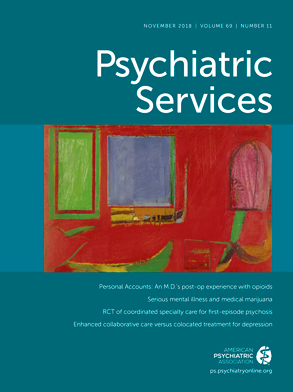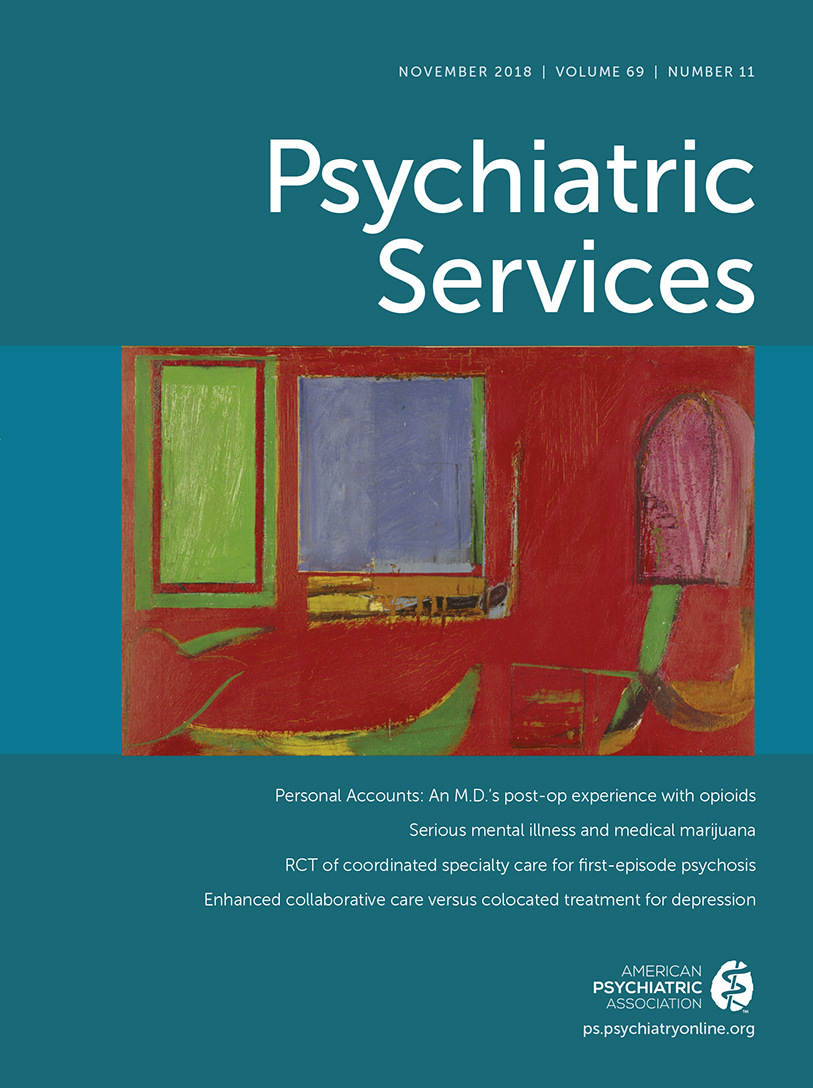Behavioral health conditions contribute significantly to the global burden of disease (
1), excess mortality related to general medical conditions (
2), and high health care costs (
3). However, only a minority of patients who need behavioral health treatment receive it (
4,
5). Many go undiagnosed and untreated, especially in racially diverse and economically vulnerable populations that face substantial barriers to accessing care. Most persons with behavioral health conditions present in primary care, where limited time and resources make identification and management challenging. Addressing this well-documented gap in care has encouraged more policy support for integration of behavioral health services into primary care, with the goal of improving care quality, health outcomes, and patient and provider satisfaction, as well as reducing costs (
6,
7).
Effectiveness of integration models has been described generally in several ways, consisting primarily of colocated and collaborative care (
8–
12). However, research comparing the clinical outcomes of these two models is limited. In the traditional colocation model, a behavioral health specialist (for example, licensed social worker, psychologist, advanced practice nurse, or psychiatrist) works in the same practice as the primary care team. Patients may be identified through screening or clinical recognition of symptoms, and the primary care provider (PCP) typically refers patients to one or more behavioral health providers for evaluation and treatment. Communication between the behavioral health providers and the PCP may be limited, with some integration of behavioral and general medical treatment plans and documentation. Colocation alone has been shown to improve initial visit engagement for depression treatment compared with off-site specialty referral, but colocation has not demonstrated better depression outcomes (
9,
12).
The collaborative care model (CoCM) is frequently cited as the integrated model with the most significant empirical support (
8,
10–
13). Key to the CoCM is a team-based approach that can more efficiently meet population health care demands and individual patient needs through collaborative management. Behavioral health teams, including a care manager, monitor patient progress and outcomes through measurement-informed care facilitated by a patient registry and provide timely treatment adjustment and regular psychiatric case reviews to PCPs. CoCM has been shown to improve outcomes in multiple randomized controlled trials and real-world implementations (
8,
11).
In this study, we undertook a cross-sectional prospective comparison of colocated care and the CoCM for patients reporting clinically significant depression symptoms in primary care in order to assess differences in clinical outcomes.
Methods
The study was conducted in an urban academic medical center with large ambulatory care practices primarily serving racially and ethnically diverse Medicaid and Medicare recipients. Starting in 2014, as part of routine care, patients with behavioral health needs had access to integrated colocated behavioral health care with a psychiatrist and clinical social worker located in 19 sites. These sites engaged in systematic depression screening with the Patient Health Questionnaire–2 (PHQ-2), had access to on-site clinical social work counseling, psychotherapy and psychiatric consultation, and had an electronic medical record (EMR) in which behavioral and general medical health were integrated. In February 2015, a subgroup of seven sites began to implement the CoCM through a Health Care Innovations Award funded by the Center for Medicare and Medicaid Innovations. The CoCM initiative aimed to further improve care quality and behavioral and general medical health outcomes through the addition of an on-site behavioral health care manager. The care manager facilitated collaboration between PCPs and the behavioral team and provided enhanced “between visit” patient care with systematic follow-up and behavioral activation; regular psychiatrist case review meetings with care managers, social workers, and PCPs; and application of measurement-informed, stepped care facilitated by a patient registry. This study was approved by the institutional review board of the Albert Einstein College of Medicine.
To identify individuals needing behavioral health services, patients were systematically screened with the PHQ-2 for depression symptoms in all sites when they registered for their primary care appointment. If the patient’s screen was positive (PHQ-2 score of ≥3), the nurse or PCP asked the patient to complete the PHQ-9 to further explore depression symptoms and assist with clinical diagnosis. Patients with clinically significant depression symptoms (PHQ-9 score of ≥10) were offered a range of patient-centered treatment options, including short-term counseling (for example, problem-solving therapy, behavioral activation, and motivational interviewing) or medication management with the PCP or psychiatrist. At CoCM sites, patients additionally received enhanced between-visit outreach to assist with treatment plan engagement, treatment intensification, and self-management guidance by the care manager. Psychiatrist case reviews were routinely provided, with in-person consultation when necessary, and patient outcomes were tracked by using the patient registry.
Potential study patients at colocation or CoCM sites were identified by extracting baseline PHQ-9 scores of ≥10 from the EMR into a weekly list. Potential participants were contacted by telephone beginning at ten weeks after the initial PHQ-9 administration (mean=12 weeks; range 10–16 weeks) for a follow up PHQ-9 assessment by a trained research assistant blinded to the integration model (colocation versus CoCM). Research assistants were instructed to make three call attempts. If patients did not respond before 16 weeks or declined participation, they were excluded. Consenting patients with qualifying PHQ-9 baseline scores were included in the study irrespective of whether they adhered to treatment.
The primary clinical outcome was severity of depression symptoms, as measured by the PHQ-9 at baseline and 12-week follow-up. Unadjusted comparisons of mean 12-week PHQ-9 scores between the colocation and the CoCM groups were made with two-sample t tests. Process measures included mean frequency of contacts with members of the behavioral health care team and percentage of patients prescribed a psychiatric medication during treatment. Data were analyzed by SAS Enterprise Guide 7.1 software.
Results
A total of 561 eligible patients were contacted, and 240 (43%) consented and enrolled (N=122 at colocation sites; N=118 at the CoCM sites). No significant difference in PHQ-9 depression severity was observed for patients who agreed to participate and those who declined. For enrolled patients, observed characteristics did not differ between the colocation and the CoCM groups, with the exception of a statistically significant difference in primary insurance. At the colocation sites, 84% (N=103) of patients were insured by Medicaid or Medicare, compared with 66% (N=78) of patients at the CoCM sites (
Table 1).
Reductions in PHQ-9 scores were significantly different between baseline and 12-week follow-up for both groups. A 33% reduction in PHQ-9 scores was observed in the CoCM sites, compared with a 14% reduction in the colocation sites. The unadjusted mean change in PHQ-9 from baseline to follow-up was 2.8 (p=.001) points greater in the CoCM group compared with the colocation group.
Given the differences in primary insurance coverage, a multiple linear regression analysis was conducted to assess the difference in the initial and follow-up PHQ-9 scores between groups, and the following potential confounders were included: age, sex, insurance type (commercial, Medicaid, or Medicare), and baseline PHQ-9 score. After adjustment for baseline differences, the greater reduction in depression symptoms observed at follow-up for the CoCM sites compared with the colocation sites remained significant (p=.003).
Mean frequency of contact with behavioral health providers was also examined in both models (
Table 1). A significantly greater total number of contacts by treating clinicians was observed in the CoCM sites, compared with the colocation sites (502 versus 297, p<.001). In the CoCM group, 58% (N=69) of patients received at least one contact by a care manager, and 69% of all care manager contacts were conducted by phone. In addition, 74% (N=87) of patients in the CoCM group received at least one social worker contact, compared with 57% (N=69) of patients in the colocation group (p=.001). Moreover, CoCM patient contacts included significantly more PHQ-9 assessments to monitor treatment response, compared with the colocation patient contacts (mean±SD=2.76±1.68 versus 1.49±.96 administrations, respectively). The number of patients prescribed psychiatric medications did not differ significantly between groups (CoCM, N=35, 30%; colocation, N=49, 40%).
Discussion
This study is one of the first to compare colocated care with the CoCM in a real-world implementation. The CoCM intervention resulted in a significantly greater reduction in depression symptoms compared with the colocation model. The findings indicated that patients at CoCM sites had almost three times as many mean contacts (three versus one) with behavioral health specialists than those at colocation sites by the 12-week follow-up. This difference was largely driven by social worker and care manager contacts. Although we could not ascertain the frequency and types of interventions provided, the CoCM emphasized problem-solving therapy and cognitive-behavioral therapy by social workers and behavioral activation and self-management education by care mangers.
The inclusion of a care manager in the CoCM team to facilitate communication and provide between-session outreach for treatment adherence and self-management education may improve model efficiency and contribute to the improved clinical outcomes observed at the CoCM sites. The CoCM training emphasized early follow-up, PHQ-9 measurement, and registry tracking—elements supported by care managers and social workers. Research has shown that key components in improving outcomes include care management and interdisciplinary communication (
14,
15), systematic follow-up, patient education, and counseling to promote engagement and adherence (
13). Of note, no significant difference was observed in medication prescribing rates in the two models. We were unable to determine whether medication adherence rates differed between the CoCM and colocation groups.
The study had important limitations, including a relatively small sample and nonrandom assignment of CoCM and colocation sites. Results also may be biased by the difference in insurance types between groups; however, baseline depression symptom scores were similar between groups, and our regression analysis nevertheless found that the CoCM resulted in greater symptom reduction. Generalizability to other settings and populations may be limited, given that all study sites were part of the same large urban academic medical center. Also, the design did not allow investigators to collect data on other potential confounding factors that may have influenced outcomes, including general medical and behavioral health comorbidities and medication adherence.
During the study period, best practice guidelines for depression treatment were routinely shared and implemented within the common EMR for all sites; therefore, potential cross-contamination between the models cannot be eliminated as the colocation sites began to learn some elements of the CoCM (for example, workflow changes and increased communication with the PCPs). However, the possibility of some model overlap between the colocation and the CoCM sites may make the main finding that patients in the CoCM had significantly greater clinical improvement more compelling. The study design made it difficult to evaluate the unique impact of any individual CoCM component on clinical outcomes. Although patients at the CoCM sites had almost twice the number of contacts by treating clinicians compared with patients at the colocation sites, more research is also needed to determine whether this was a sufficient dose to improve outcomes.
Conclusions
The CoCM appears to offer a more effective model for providing treatment of depression symptoms in primary care, compared with the colocation model. Given the upfront investment and wide-scale system and culture changes involved in integrating behavioral health in primary care settings, identifying the most effective model for improving care quality and clinical outcomes while maximizing limited resources is crucial for convincing stakeholders to invest in sustaining and scaling integrated care.

